
The most distant human-made object
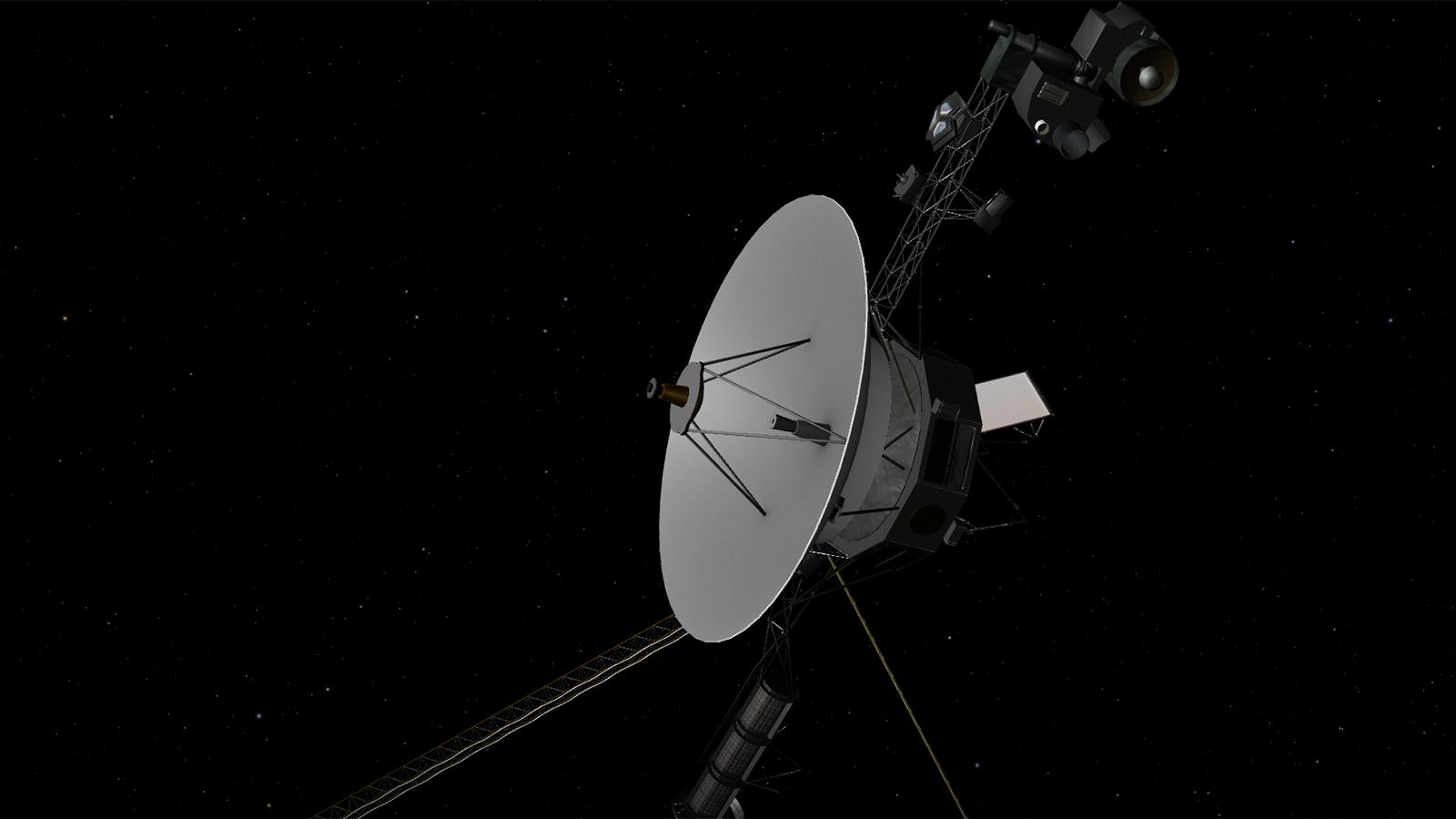
No spacecraft has gone farther than NASA's Voyager 1. Launched in 1977 to fly by Jupiter and Saturn, Voyager 1 crossed into interstellar space in August 2012 and continues to collect data.
Mission Type

Latest News
Still Kickin’ Since the ’70s: NASA’s Voyager Mission Keeps Exploring

Un viaje poético a la luna Europa

Voyager 1 Team Accomplishes Tricky Thruster Swap

Voyager 1 Returning Science Data From All Four Instruments

Ed Stone, Former Director of JPL, Voyager Project Scientist, Dies
What is Voyager 1?
Voyager 1 has been exploring our solar system since 1977. The probe is now in interstellar space, the region outside the heliopause, or the bubble of energetic particles and magnetic fields from the Sun. Voyager 1 was launched after Voyager 2, but because of a faster route it exited the asteroid belt earlier than its twin, and it overtook Voyager 2 on Dec. 15, 1977.
- Voyager 1 discovered a thin ring around Jupiter and two new Jovian moons: Thebe and Metis.
- At Saturn, Voyager 1 found five new moons and a new ring called the G-ring.
- Voyager 1 was the first spacecraft to cross the heliosphere, the boundary where the influences from outside our solar system are stronger than those from our Sun.
- Voyager 1 is the first human-made object to venture into interstellar space.
In Depth: Voyager 1
Voyager 1 launched after Voyager 2, but because of a faster route it exited the solar system earlier than its twin. Voyager 1 overtook Voyager 2 on Dec. 15, 1977.
Voyager 1 began studying Jupiter in April 1978 at a range of 165 million miles (265 million km). Images showed Jupiter’s atmosphere to be more turbulent than during the Pioneer 10 and 11 flybys. Voyager 1 took a picture every 96 seconds to create a timelapse movie of the approach.
In early 1979, Voyager 1 discovered a faint ring system around Jupiter. The spacecraft’s closest encounter with Jupiter was at 12:05 UT on March 5, 1979 at a range of 174,000 miles (280,000 km), It went on to encounter several of Jupiter’s moons, including Amalthea , Io , Europa , Ganymede , and Callisto . Spectacular close-up photos of the moons opened up completely new worlds for planetary scientists. The spacecraft discovered two new moons, Thebe and Metis .
Its flyby of the Saturn system in November 1979 was as spectacular as the Jupiter encounter. Voyager 1 found five new moons, a new ring, and complicated ring structures, including “shepherd moons” that keep some rings well-defined. The spacecraft photographed Saturn’s moons Titan , Mimas , Enceladus , Tethys , Dione , and Rhea . All the moons appeared to be composed largely of water ice.
Images of Titan showed a thick atmosphere that completely hid the surface . The spacecraft found that the Titan’s atmosphere was composed of 90% nitrogen. Nitrogen, methane, and more complex hydrocarbons indicated prebiotic chemical reactions might be possible on Titan.
Voyager 1’s closest approach to Saturn was at 23:46 UT on Nov. 12, 1980 at a range of about 78,000 miles (126,000 km).
After Saturn, Voyager 1 headed north out of the ecliptic plane at a speed of about 3.5 AU per year. Because of the specific requirements for the Titan flyby, the spacecraft was not directed to Uranus and Neptune .
Voyager 1’s final 64 images were a mosaic taken at a distance of 40 Astronomical Units (AU) from the Sun. This solar system family portrait included six planets (Mercury and Mars were not visible). The image of Earth inspired the “ Pale Blue Dot ” made famous by Voyager science team member Carl Sagan (1934-1996). These were the last of a total of 67,000 images taken by the two Voyagers.
The Voyager Interstellar Mission (VIM) began on Jan, 1, 1990. The goal was to extend exploration to the outer limits of the Sun’s sphere of influence and beyond.
- On Feb. 17, 1998, Voyager 1 became the most distant human-made object in existence when — at a distance of 69.4 AU from the Sun — it “overtook” Pioneer 10.
- On Dec. 16, 2004, Voyager 1 reached the termination shock and entered the heliosheath .
- On Aug. 25, 2012, the spacecraft became the first to exit the heliosphere and begin measuring the interstellar environment.
Voyager 1 continues to communicate with NASA’s Deep Space Network and send data back from four still-functioning instruments — the cosmic ray telescope, the low-energy charged particles experiment, the magnetometer, and the plasma waves experiment.
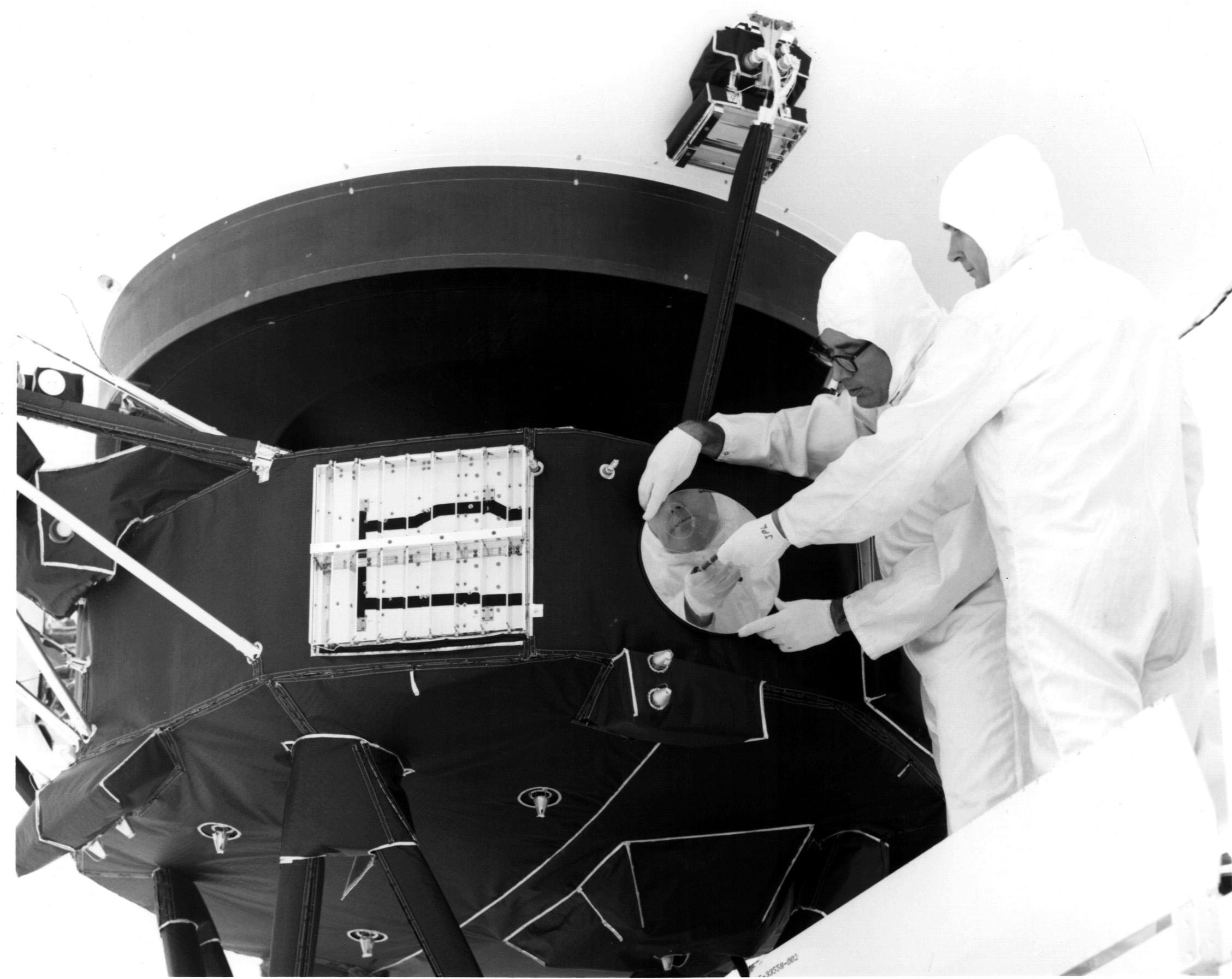
Each of the Voyagers contain a message to potential extraterrestrials in the form of a 30-centimeter diameter gold-plated copper disc. Like the plaques on Pioneers 10 and 11, the Voyager Golden Record has inscribed symbols that show the location of Earth relative to several pulsars. The record includes instructions to play it similar to a vinyl record player.
Audio on the disc includes greetings in 55 languages, 35 sounds from life on Earth (such as whale songs, laughter, etc.), 90 minutes of music including everything from Mozart and Bach to Chuck Berry and Blind Willie Johnson. It also includes 115 images of life on Earth and recorded greetings from then U.S. President Jimmy Carter and then-UN Secretary-General Kurt Waldheim.
As of Aug. 21, 2024, Voyager 1 was 164.7 AU from Earth — the farthest object created by humans — moving at a velocity of 38,026.79 mph (17.0 km/second) relative to the Sun.
Adapted from Asif A. Saddiqi’s “ Beyond Earth: A Chronicle of Deep Space Exploration ,” NASA History Office, 2018.
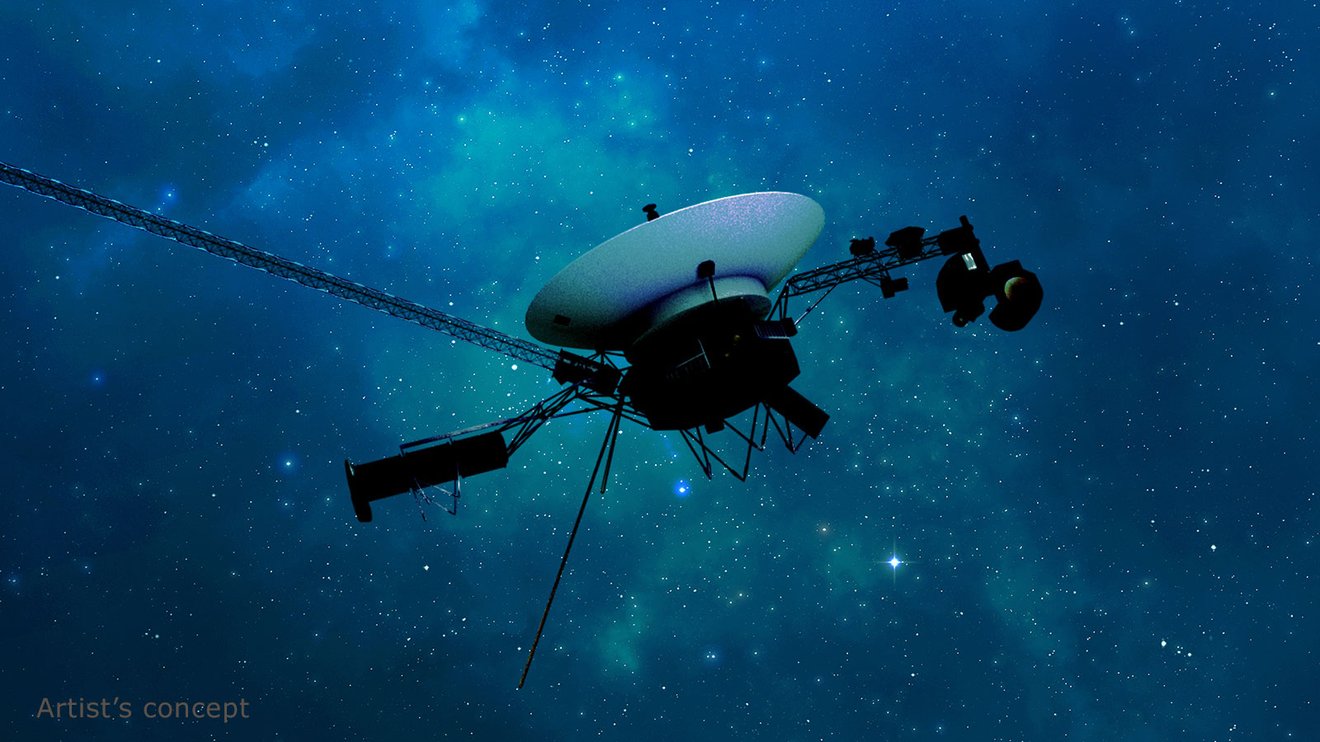
National Space Science Data Center: Voyager 1
A library of technical details and historic perspective.

Beyond Earth: A Chronicle of Deep Space Exploration
A comprehensive history of missions sent to explore beyond Earth.

Discover More Topics From NASA
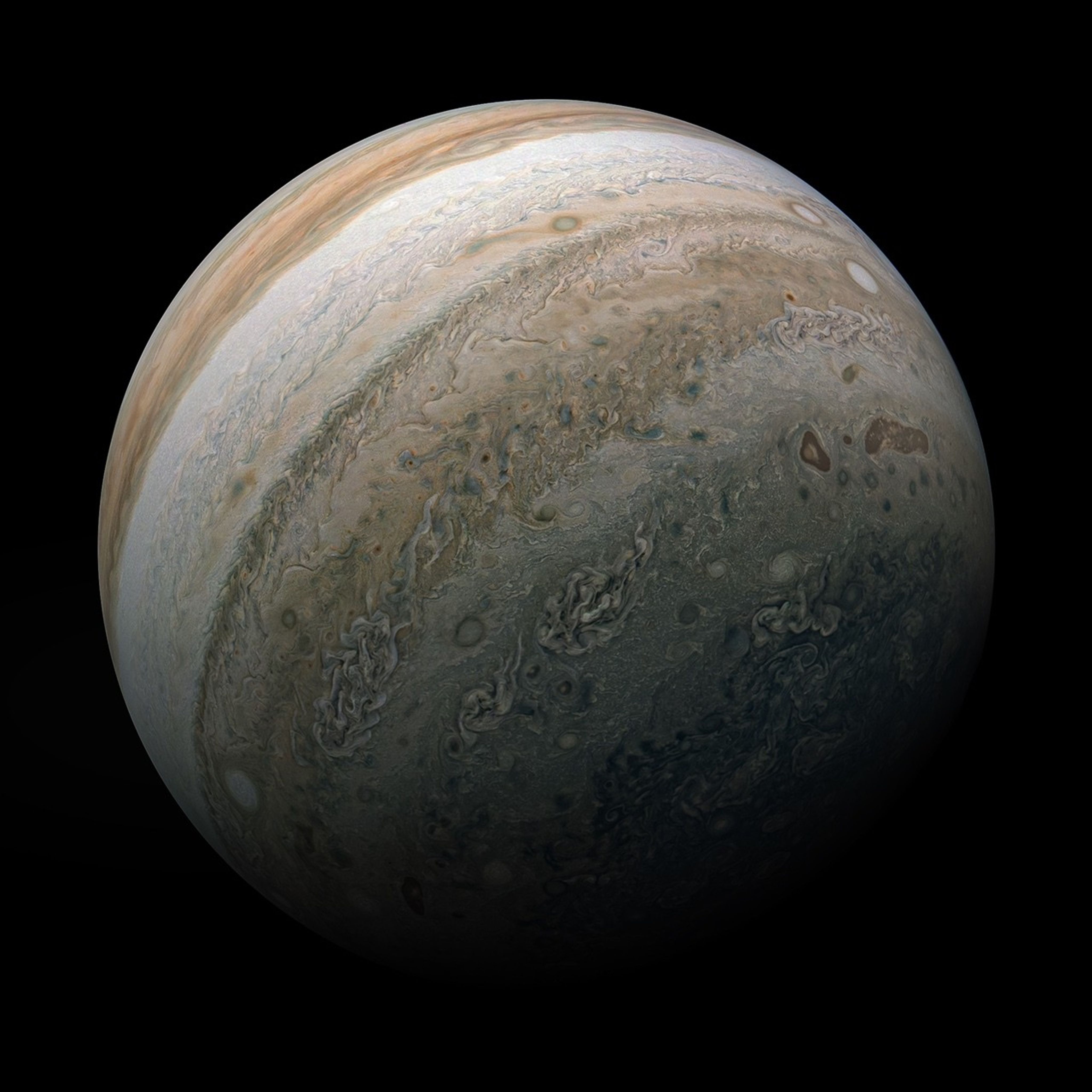
Our Solar System
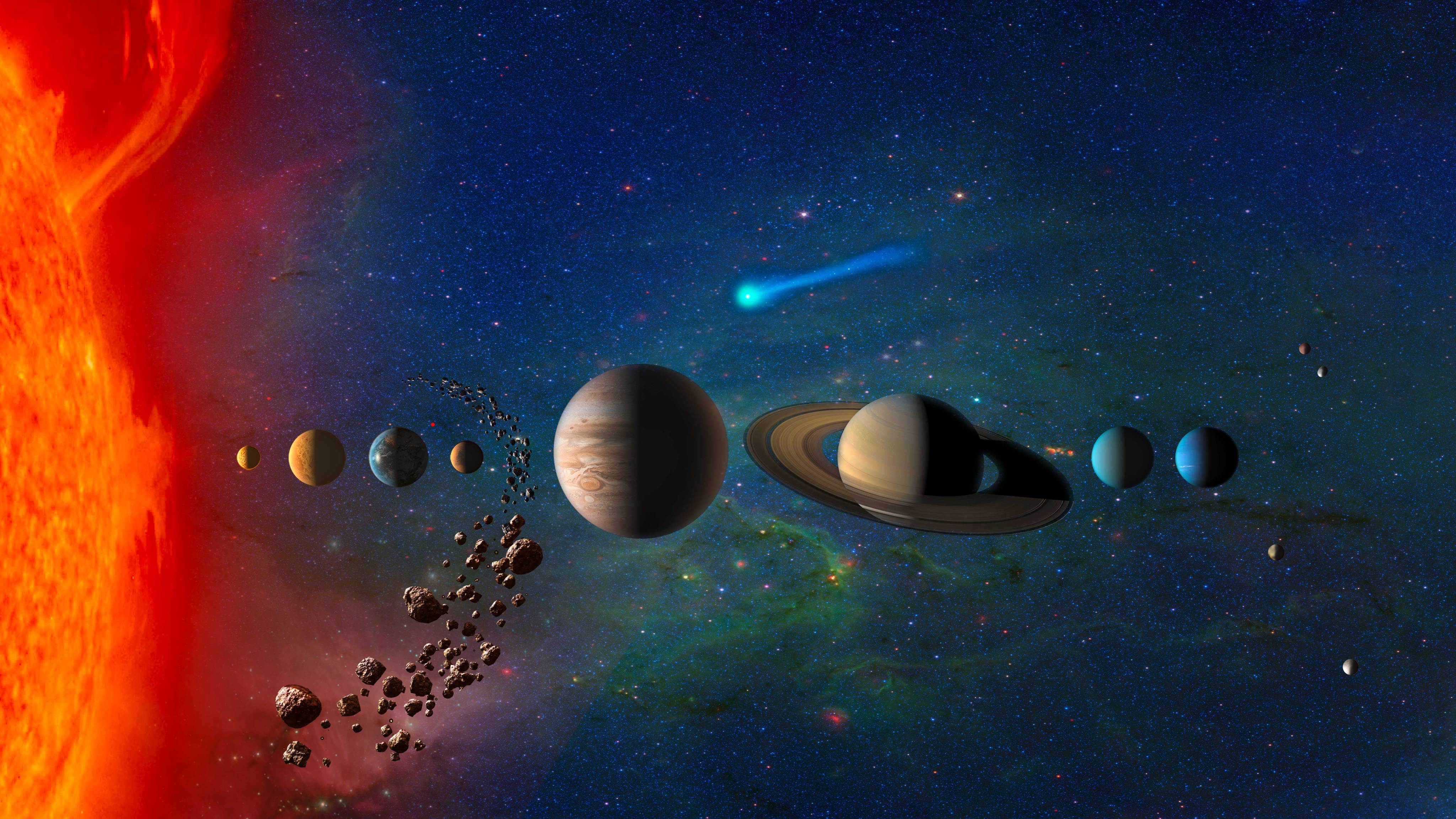
Voyager 1: Facts about Earth's farthest spacecraft
Voyager 1 continues to explore the cosmos along with its twin probe, Voyager 2.
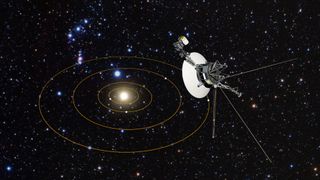
The Grand Tour
Voyager 1 jupiter flyby, voyager 1 visits saturn and its moons, voyager 1 enters interstellar space, voyager 1's interstellar adventures, additional resources.
Voyager 1 is the first spacecraft to travel beyond the solar system and reach interstellar space .
The probe launched on Sept. 5, 1977 — about two weeks after its twin Voyager 2 — and as of August 2022 is approximately 14.6 billion miles (23.5 billion kilometers) away from our planet, making it Earth 's farthest spacecraft. Voyager 1 is currently zipping through space at around 38,000 mph (17 kilometers per second), according to NASA Jet Propulsion Laboratory .
When Voyager 1 launched a mission to explore the outer planets in our solar system nobody knew how important the probe would still be 45 years later The probe has remained operational long past expectations and continues to send information about its journeys back to Earth.
Related: Celebrate 45 years of Voyager with these amazing images of our solar system (gallery)
- Voyager Spacecraft: Beyond the Solar System
- Voyager 2: An iconic spacecraft that's still exploring 45 years on
Elizabeth Howell, Ph.D., is a staff writer in the spaceflight channel since 2022. She was contributing writer for Space.com for 10 years before that, since 2012. Elizabeth's on-site reporting includes two human spaceflight launches from Kazakhstan, three space shuttle missions in Florida, and embedded reporting from a simulated Mars mission in Utah.
Size: Voyager 1's body is about the size of a subcompact car. The boom for its magnetometer instrument extends 42.7 feet (13 meters). Weight (at launch): 1,797 pounds (815 kilograms). Launch date: Sept. 5, 1977
Jupiter flyby date: March 5, 1979
Saturn flyby date: Nov. 12, 1980.
Entered interstellar space: Aug. 25, 2012.
The spacecraft entered interstellar space in August 2012, almost 35 years after its voyage began. The discovery wasn't made official until 2013, however, when scientists had time to review the data sent back from Voyager 1.
Voyager 1 was the second of the twin spacecraft to launch, but it was the first to race by Jupiter and Saturn . The images Voyager 1 sent back have been used in schoolbooks and by many media outlets for a generation. The spacecraft also carries a special record — The Golden Record — that's designed to carry voices and music from Earth out into the cosmos.
According to NASA Jet Propulsion Laboratory (JPL) , Voyager 1 has enough fuel to keep its instruments running until at least 2025. By then, the spacecraft will be approximately 13.8 billion miles (22.1 billion kilometers) away from the sun.
The Voyager missions took advantage of a special alignment of the outer planets that happens just once every 176 years. This alignment allows spacecraft to gravitationally "slingshot" from one planet to the next, making the most efficient use of their limited fuel.
NASA originally planned to send two spacecraft past Jupiter, Saturn and Pluto and two other probes past Jupiter, Uranus and Neptune . Budgetary reasons forced the agency to scale back its plans, but NASA still got a lot out of the two Voyagers it launched.
Voyager 2 flew past Jupiter, Saturn, Uranus and Neptune , while Voyager 1 focused on Jupiter and Saturn.
Recognizing that the Voyagers would eventually fly to interstellar space, NASA authorized the production of two Golden Records to be placed on board the spacecraft. Sounds ranging from whale calls to the music of Chuck Berry were placed on board, as well as spoken greetings in 55 languages.
The 12-inch-wide (30 centimeters), gold-plated copper disks also included pictorials showing how to operate them and the position of the sun among nearby pulsars (a type of fast-spinning stellar corpse known as a neutron star ), in case extraterrestrials someday stumbled onto the spacecraft and wondered where they came from.
Both spacecraft are powered by three radioisotope thermoelectric generators , devices that convert the heat released by the radioactive decay of plutonium to electricity. Both probes were outfitted with 10 scientific instruments, including a two-camera imaging system, multiple spectrometers, a magnetometer and gear that detects low-energy charged particles and high-energy cosmic rays . Mission team members have also used the Voyagers' communications system to help them study planets and moons, bringing the total number of scientific investigations on each craft to 11.
Voyager 1 almost didn't get off the ground at its launch , as its rocket came within 3.5 seconds of running out of fuel on Sept. 5, 1977.
But the probe made it safely to space and raced past its twin after launch, getting beyond the main asteroid belt between Mars and Jupiter before Voyager 2 did. Voyager 1's first pictures of Jupiter beamed back to Earth in April 1978, when the probe was 165 million miles (266 million kilometers) from home.
According to NASA , each voyager probe has about 3 million times less memory than a mobile phone and transmits data approximately 38,000 times slower than a 5g internet connection.
To NASA's surprise, in March 1979 Voyager 1 spotted a thin ring circling the giant planet. It found two new moons as well — Thebe and Metis. Additionally, Voyager 1 sent back detailed pictures of Jupiter's big Galilean moons ( Io , Europa , Ganymede and Callisto ) as well as Amalthea .
Like the Pioneer spacecraft before it , Voyager's look at Jupiter's moons revealed them to be active worlds of their own. And Voyager 1 made some intriguing discoveries about these natural satellites. For example, Io's many volcanoes and mottled yellow-brown-orange surface showed that, like planets, moons can have active interiors.
Additionally, Voyager 1 sent back photos of Europa showing a relatively smooth surface broken up by lines, hinting at ice and maybe even an ocean underneath. (Subsequent observations and analyses have revealed that Europa likely harbors a huge subsurface ocean of liquid water, which may even be able to support Earth-like life .)
Voyager 1's closest approach to Jupiter was on March 5, 1979, when it came within 174,000 miles (280,000 km) of the turbulent cloud tops. Then it was time for the probe to aim for Saturn.
Scientists only had to wait about a year, until 1980, to get close-up pictures of Saturn. Like Jupiter, the ringed planet turned out to be full of surprises.
One of Voyager 1's targets was the F ring, a thin structure discovered only the year previously by NASA's Pioneer 11 probe. Voyager's higher-resolution camera spotted two new moons, Prometheus and Pandora, whose orbits keep the icy material in the F ring in a defined orbit. It also discovered Atlas and a new ring, the G ring, and took images of several other Saturn moons.
One puzzle for astronomers was Titan , the second-largest moon in the solar system (after Jupiter's Ganymede). Close-up pictures of Titan showed nothing but orange haze, leading to years of speculation about what it was like underneath. It wouldn't be until the mid-2000s that humanity would find out, thanks to photos snapped from beneath the haze by the European Space Agency's Huygens atmospheric probe .
The Saturn encounter marked the end of Voyager 1's primary mission. The focus then shifted to tracking the 1,590-pound (720 kg) craft as it sped toward interstellar space.
Two decades before it notched that milestone, however, Voyager 1 took one of the most iconic photos in spaceflight history. On Feb. 14, 1990, the probe turned back toward Earth and snapped an image of its home planet from 3.7 billion miles (6 billion km) away. The photo shows Earth as a tiny dot suspended in a ray of sunlight.
Voyager 1 took dozens of other photos that day, capturing five other planets and the sun in a multi-image "solar system family portrait." But the Pale Blue Dot picture stands out, reminding us that Earth is a small outpost of life in an incomprehensibly vast universe.
Voyager 1 left the heliosphere — the giant bubble of charged particles that the sun blows around itself — in August 2012, popping free into interstellar space. The discovery was made public in a study published in the journal Science the following year.
The results came to light after a powerful solar eruption was recorded by Voyager 1's plasma wave instrument between April 9 and May 22, 2013. The eruption caused electrons near Voyager 1 to vibrate. From the oscillations, researchers discovered that Voyager 1's surroundings had a higher density than what is found just inside the heliosphere.
It seems contradictory that electron density is higher in interstellar space than it is in the sun's neighborhood. But researchers explained that, at the edge of the heliosphere, the electron density is dramatically low compared with locations near Earth.
Researchers then backtracked through Voyager 1's data and nailed down the official departure date to Aug. 25, 2012. The date was fixed not only by the electron oscillations but also by the spacecraft's measurements of charged solar particles.
On that fateful day — which was the same day that Apollo 11 astronaut Neil Armstrong died — the probe saw a 1,000-fold drop in these particles and a 9% increase in galactic cosmic rays that come from outside the solar system . At that point, Voyager 1 was 11.25 billion miles (18.11 billion km) from the sun, or about 121 astronomical units (AU).
One AU is the average Earth-sun distance — about 93 million miles (150 million km).
You can keep tabs on the Voyager 1's current distance and mission status on this NASA website .
Since flying into interstellar space, Voyager 1 has sent back a variety of valuable information about conditions in this zone of the universe . Its discoveries include showing that cosmic radiation out there is very intense, and demonstrating how charged particles from the sun interact with those emitted by other stars , mission project scientist Ed Stone, of the California Institute of Technology in Pasadena, told Space.com in September 2017 .
The spacecraft's capabilities continue to astound engineers. In December 2017, for example, NASA announced that Voyager 1 successfully used its backup thrusters to orient itself to "talk" with Earth . The trajectory correction maneuver (TCM) thrusters hadn't been used since November 1980, during Voyager 1's flyby of Saturn. Since then, the spacecraft had primarily used its standard attitude-control thrusters to swing the spacecraft in the right orientation to communicate with Earth.
As the performance of the attitude-control thrusters began to deteriorate, however, NASA decided to test the TCM thrusters — an idea that could extend Voyager 1's operational life. That test ultimately succeeded.
"With these thrusters that are still functional after 37 years without use, we will be able to extend the life of the Voyager 1 spacecraft by two to three years," Voyager project manager Suzanne Dodd, of NASA's Jet Propulsion, Laboratory (JPL) in Southern California, said in a statement in December 2017 .
Mission team members have taken other measures to extend Voyager 1's life as well. For example, they turned off the spacecraft's cameras shortly after the Pale Blue Dot photo was taken to help conserve Voyager 1's limited power supply. (The cameras wouldn't pick up much in the darkness of deep space anyway.) Over the years, the mission team has turned off five other scientific instruments as well, leaving Voyager 1 with four that are still functioning — the Cosmic Ray Subsystem, the Low-Energy Charged Particles instrument, the Magnetometer and the Plasma Wave Subsystem. (Similar measures have been taken with Voyager 2, which currently has five operational instruments .)
The Voyager spacecraft each celebrated 45 years in space in 2022, a monumental milestone for the twin probes.
"Over the last 45 years, the Voyager missions have been integral in providing this knowledge and have helped change our understanding of the sun and its influence in ways no other spacecraft can," says Nicola Fox, director of the Heliophysics Division at NASA Headquarters in Washington, in a NASA statement .
"Today, as both Voyagers explore interstellar space, they are providing humanity with observations of uncharted territory," said Linda Spilker, Voyager's deputy project scientist at JPL in the same NASA statement.
"This is the first time we've been able to directly study how a star, our Sun, interacts with the particles and magnetic fields outside our heliosphere, helping scientists understand the local neighborhood between the stars, upending some of the theories about this region, and providing key information for future missions." Spilker continues.
Voyager 1's next big encounter will take place in 40,000 years when the probe comes within 1.7 light-years of the star AC +79 3888. (The star is roughly 17.5 light-years from Earth.) However, Voyager 1's falling power supply means it will probably stop collecting scientific data around 2025.
You can learn much more about both Voyagers' design, scientific instruments and mission goals at JPL's Voyager site . NASA has lots of in-depth information about the Pale Blue Dot photo, including Carl Sagan's large role in making it happen, here . And if you're interested in the Golden Record, check out this detailed New Yorker piece by Timothy Ferris, who produced the historic artifact. Explore the history of Voyager with this interactive timeline courtesy of NASA.
Bibliography
- Bell, Jim. " The Interstellar Age: Inside the Forty-Year Voyager Mission ," Dutton, 2015.
- Landau, Elizabeth. "The Voyagers in popular culture," Dec. 1, 2017. https://www.nasa.gov/feature/jpl/the-voyagers-in-popular-culture
- PBS, "Voyager: A history in photos." https://www.pbs.org/the-farthest/mission/voyager-history-photos/
Join our Space Forums to keep talking space on the latest missions, night sky and more! And if you have a news tip, correction or comment, let us know at: [email protected].
Get the Space.com Newsletter
Breaking space news, the latest updates on rocket launches, skywatching events and more!
Elizabeth Howell (she/her), Ph.D., is a staff writer in the spaceflight channel since 2022 covering diversity, education and gaming as well. She was contributing writer for Space.com for 10 years before joining full-time. Elizabeth's reporting includes multiple exclusives with the White House and Office of the Vice-President of the United States, an exclusive conversation with aspiring space tourist (and NSYNC bassist) Lance Bass, speaking several times with the International Space Station, witnessing five human spaceflight launches on two continents, flying parabolic, working inside a spacesuit, and participating in a simulated Mars mission. Her latest book, " Why Am I Taller ?", is co-written with astronaut Dave Williams. Elizabeth holds a Ph.D. and M.Sc. in Space Studies from the University of North Dakota, a Bachelor of Journalism from Canada's Carleton University and a Bachelor of History from Canada's Athabasca University. Elizabeth is also a post-secondary instructor in communications and science at several institutions since 2015; her experience includes developing and teaching an astronomy course at Canada's Algonquin College (with Indigenous content as well) to more than 1,000 students since 2020. Elizabeth first got interested in space after watching the movie Apollo 13 in 1996, and still wants to be an astronaut someday. Mastodon: https://qoto.org/@howellspace
- Daisy Dobrijevic Reference Editor
SpaceX launching 20 Starlink satellites from California tonight
SpaceX rolls Starship Flight 6 spacecraft to pad ahead of Nov. 18 launch — and it's wearing a banana (photos)
All astronauts still in good health on ISS, NASA flight surgeon says amid new tabloid rumors
Most Popular
- 2 Former Virgin Galactic CEO George Whitesides wins seat in US Congress
- 3 SpaceX launching 20 Starlink satellites from California tonight
- 4 Top Black Friday space gifts at Walmart
- 5 UFO whistleblowers tell Congress 'we are not alone in the cosmos' (video)

IMAGES
VIDEO